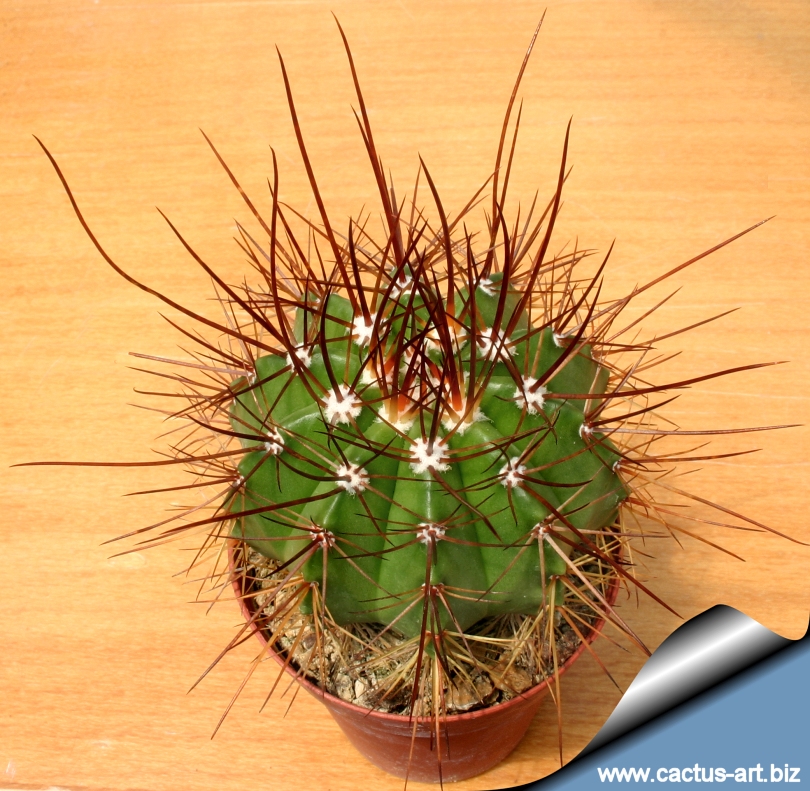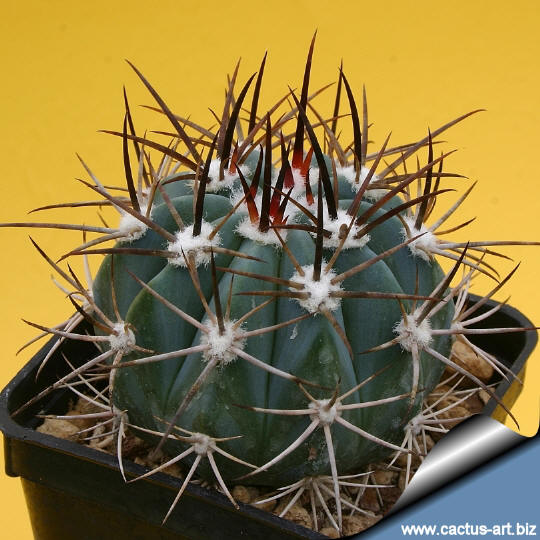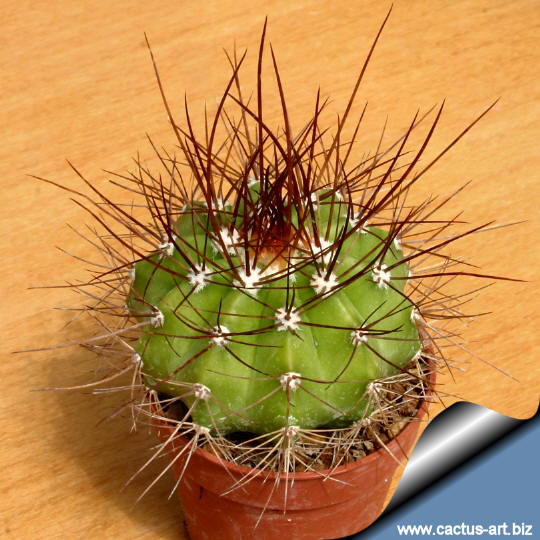|
|
|

Melocactus erythracanthus ( Long
spined form )
This is one of the longest spined species of the genus, but quite
variable regarding the length of the spines and plants from
different provenience will be remarkably different.
|
|
Description: Melocactus
erythracanthus is
one of the larger Melocactus and also one of the longest spined species
of the genus. Usually it stay solitary, it is also a quite variable
species in size colour and form of the spines.
Stem: Globose to conical strongly longitudinally ribbed, up to 45
cm tall, 35 cm in diameter. Mature plants are easily recognizable by
their
cephalium, that have a covering of wool and bristles, The immature
plant looks like a smallish barrel cactus, and there is nothing in its
appearance that would suggest a Melocactus.
Ribs: 10 to 13.
The most remarkable part of a Melocactus is its
cephalium a
bristle-coated structure on the summit of the plant, only Melocactus,
and the similar genus
Discocactus
possesses this type of permanent, apical, hatlike appendage. It’s only
when a Melocactus reaches maturity that the cephalium begins to
grow. Cylindrical, with a diameter distinctly smaller than that of the
plant body below, the cephalium will keep growing for the rest of the
plant’s life, but the body of the plant stops growing the moment the
cephalium starts to form. . As the plants age the cephalium doesn’t
increase in circumference it will steadily grow taller
|
|
Cultivation: These cacti are not the easiest
things to grow and aren’t plants for beginners.
Melocactus erythracanthus
grows from April to October, it can’t endure long stretches of total
dryness, and also too much water will rot it, as its weak root systems
tends to be inefficient at sucking up water from wet soil. Nonetheless,
again as a result of their tropical origins, they need a fair amount of
water, but allow the soil to dry quite a bit before watering again.
Melocactus rests from October to April but can’t stand cold, or even
fairly cool temperatures, so is indispensable to keep it above 8-12°C at
all times, severe damage or death occurring at temperatures that the
great majority of cacti wouldn’t mind in the least and prefer more
frequent water in winter than other cacti, say once a month. Do not feed
in winter.
The root system is weak and generally resents being repotted and can
take a long time to re-establish. The soil mix should be very quick
draining, prefers very bright light, not as much as the most arid
growing cacti, but plenty nonetheless.
Propagation: Exclusively by Seeds. Sow in
February-march in a light, sandy, porous soil. Cover germinating tray
with glass to prevent seed from drying out. Germination is most
successful at a temperature of 18 to 22° C.
Photo of conspecific taxa, varieties, forms and cultivars
of plants belonging
to the Melocactus ernestii
complex
(This
Taxon has lots of
synonyms ( like many other
cacti) whit several controversial
varieties and subspecies and comprises a multitude of different
forms, but where each form is linked to others by populations of plants
with intermediate characteristics):

 |
|
Advertising
|
|
|
|
|
Family:
Cactaceae (Cactus
Family) |
|
Melocactus erythracanthus A.F.H.
Buining & A.J. Brederoo,
Published in: Cactus and Succulent Journal [U. S. ] 45: 223, 1973
Scientific name:
Melocactus ernestii
D. Vaupel, ssp. ernestii
Published in: Monatscr. Kakteenkunde 30, 8, 1920
Origin: M. ernestii is a critically
endangered species endemic to north-eastern Brazil. (Bahia, Minas Gerais)
It grows in
sympatry with other congeneric species and it has generated some
natural hybrid like Melocactus × albicephalus (M. ernestii ×
M. glaucescens)
Conservation status: Listed in
CITES appendix 2.
Common Name: Turk’s cap, “melon cactus” (or
simply “melon”)
|
Synonyms:
- Melocactus azulensis
- Melocactus interpositus
- Melocactus longispinus
- Melocactus nitidus
- Melocactus oreas ernestii
Melocactus neomontanus
- Melocactus deinacanthus
- Melocactus mulequensis
- Melocactus montanus
- Melocactus longispinus
- Melocactus deinacanthus ssp. florschuetzianus
- Melocactus florschuetzianus
- Melocactus oreas
- Melocactus erythracanthus
- Melocactus azulensis
- Melocactus oreas ssp. ernestii
- Melocactus ernesti
- Melocactus oreas var. longispinus
|
|
|
|

Melocactus erythracanthus ( Short spined form )
 |
|